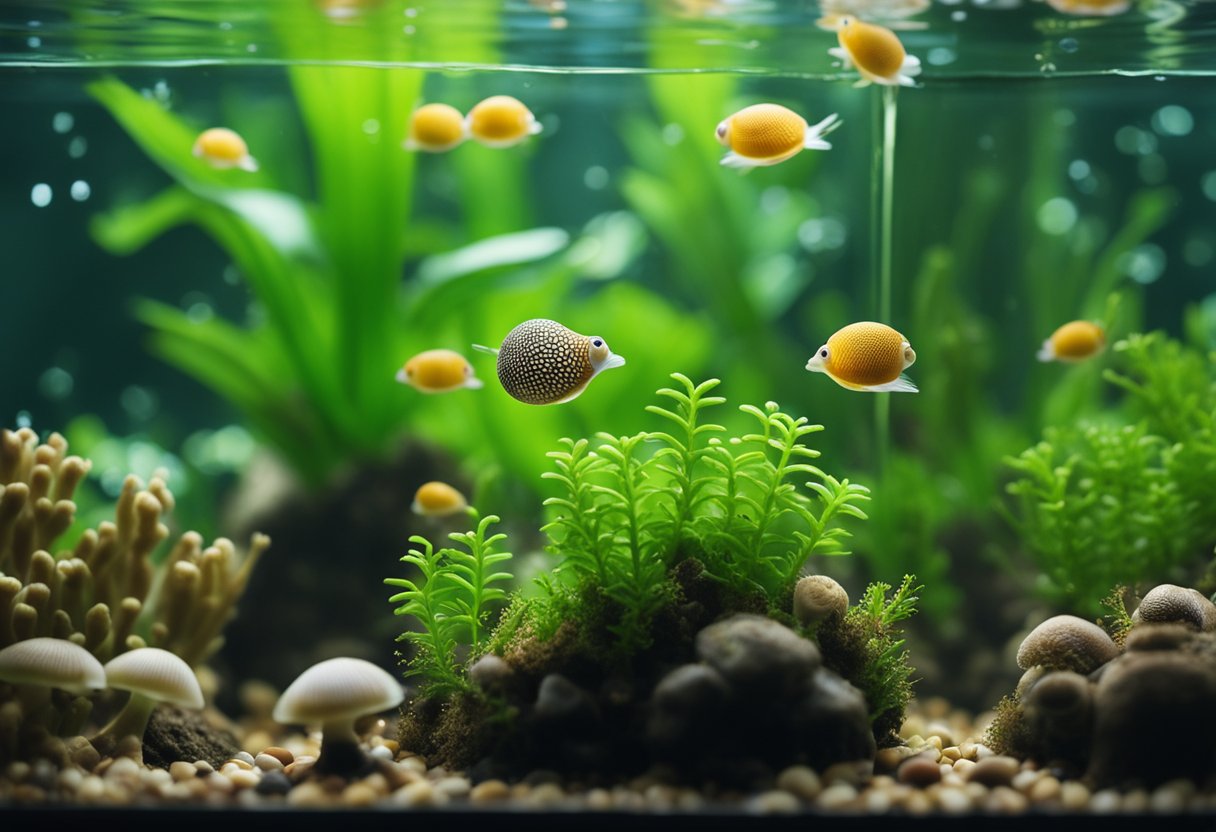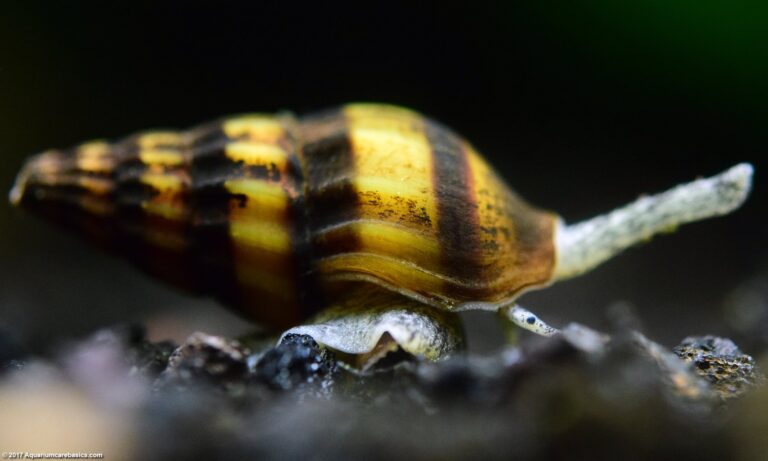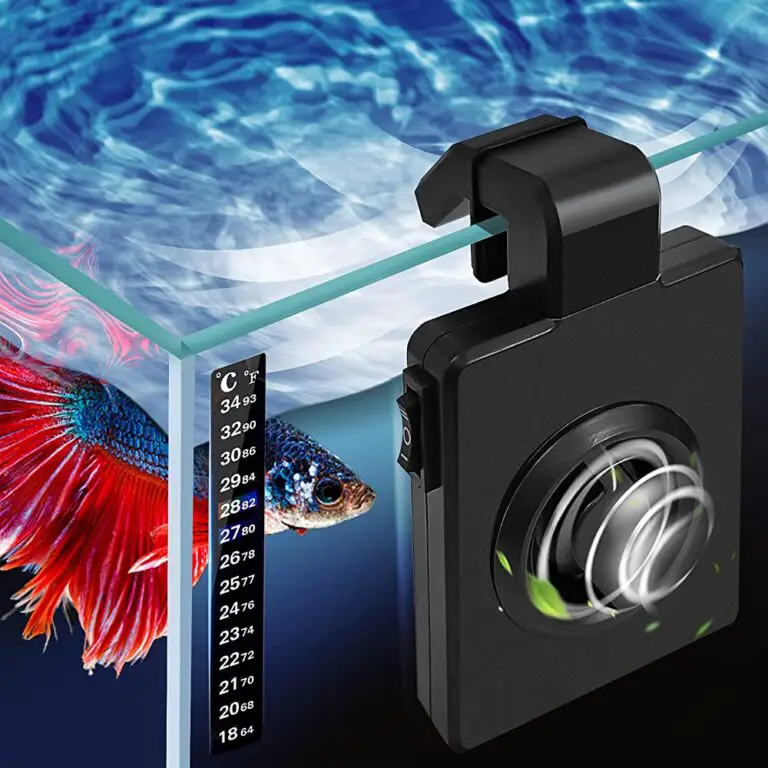Snail Eggs in Fish Tank: Prevention and Removal Tips
Snail eggs in fish tanks can be a great source of confusion and concern for many aquarists. While snails can be beneficial for the aquarium ecosystem by cleaning up algae and other debris, they can also reproduce rapidly and take over the tank.
Understanding snail eggs and their impact on the fish tank ecosystem is important for managing and controlling their population.
Snail eggs can be found in various locations in the fish tank, including above the waterline, below the waterline, on aquarium decorations, plants, or even on the aquarium glass.
Each species of snail lays unique eggs that are distinct and identifiable. Some snails lay their eggs in clusters, known as egg clutches or gelatinous sacs, while others lay hard, white, and round eggs.
Causes of snail eggs in fish tanks can include overfeeding, poor water quality, and introduction of snails from other sources. Snail eggs can have a significant impact on the fish tank ecosystem, including overpopulation, excessive waste production, and competition with other organisms for resources.
Proper management and control of snail eggs in fish tanks are essential to maintain a healthy and balanced ecosystem.
- Understanding snail eggs and their impact on the fish tank ecosystem is important for managing and controlling their population.
- Causes of snail eggs in fish tanks can include overfeeding, poor water quality, and introduction of snails from other sources.
- Proper management and control of snail eggs in fish tanks are essential to maintain a healthy and balanced ecosystem.
Understanding Snail Eggs

Snail eggs are a common sight in aquariums that house snails. They can be fascinating to observe, but they can also be a nuisance if they overpopulate the tank. I will provide some basic information on the life cycle of snail eggs and how to identify them.
Life Cycle of Snail Eggs
Snails are hermaphroditic, meaning they have both male and female reproductive organs. This allows them to mate with any other snail they encounter.
After mating, the snails will lay their eggs in clusters, known as egg clutches or gelatinous sacs.
The eggs will hatch in about 2-4 weeks, depending on the species of snail and the temperature of the water.
Once the eggs hatch, the snails will emerge as tiny versions of their parents. They will then begin to feed on algae, detritus, and other organic matter in the tank.
As they grow, they will continue to reproduce, laying more eggs and increasing the snail population in the tank.
The Lifecycle of Snails: From Eggs to Adults
Snails undergo a fascinating lifecycle that involves several stages. Understanding these stages can help fish tank owners better manage snail populations.
Here are the key stages in the lifecycle of snails:
- Egg Stage: Snail eggs are usually laid in clusters and attached to various surfaces within the fish tank, such as plants, rocks, or even the glass walls. These eggs are often translucent and can be challenging to spot.
- Hatching Stage: After a period of incubation, which can range from a few days to several weeks depending on the snail species, the eggs will hatch into tiny snails. These baby snails are known as juveniles.
- Juvenile Stage: Juvenile snails are miniature versions of adult snails and will gradually grow in size as they consume food and nutrients present in the tank. During this stage, they are particularly vulnerable to predation and may seek shelter in hard-to-reach areas.
- Adult Stage: Once the juvenile snails reach maturity, they become fully grown adult snails. At this stage, they are capable of reproducing and laying their own eggs, perpetuating the snail population cycle.
Identification of Snail Eggs
Identifying snail eggs can be tricky, as different species of snails lay different types of eggs. Some snails lay small, translucent spheres, while others lay hard, white, and round eggs.
The location of the eggs can also vary, as some snails lay their eggs on aquarium decorations, plants, or the tank’s glass.
One key aspect of managing snail populations in your aquarium is understanding their life cycle, particularly the reproductive process and the hatching of snail eggs.
How Snail Eggs Enter Your Fish Tank?
Snail eggs can enter your fish tank through various means, including:
- Live Plants: Snail eggs are often inadvertently introduced into fish tanks through live plants. These eggs can be attached to the leaves, stems, or roots of the plants. It is essential to inspect and quarantine new plants before introducing them into your tank to prevent unwanted snail infestations.
- Contaminated Decorations or Substrate: Snail eggs can also be present on decorations, rocks, or substrate that you introduce into your fish tank. It is crucial to thoroughly clean and disinfect any new additions to minimize the risk of introducing snail eggs.
- Hitchhiking on Fish: In some cases, snail eggs may hitch a ride on newly acquired fish. Snail eggs can attach themselves to the fish’s body or fins and be transported into the tank. Quarantining new fish and closely inspecting them before introducing them to your main tank can help prevent this.
Causes of Snail Eggs in Fish Tanks
As an aquarium enthusiast, it is essential to understand the causes of snail eggs in fish tanks. Here are some of the factors that contribute to the presence of snail eggs in aquariums:
Common Snail Species in Aquariums
Aquarium snails are a common occurrence in many fish tanks. Some of the most common snail species found in aquariums include:
- Ramshorn snails
- Mystery snails
- Nerite snails
- Malaysian trumpet snails
- Pond snails
These snail species reproduce quickly and can lay hundreds of eggs in a short period. Therefore, it is crucial to identify the type of snail species in your aquarium to determine the best approach to managing snail eggs.
Conditions Promoting Snail Reproduction
Several conditions promote snail reproduction in fish tanks. Some of these conditions include:
- Overfeeding: Overfeeding your fish can lead to an increase in the number of snails in the aquarium. Snails feed on leftover fish food, and an abundance of food in the aquarium can lead to a population explosion of snails.
- Poor water quality: Poor water quality can also contribute to the growth of snails in fish tanks. Snails thrive in dirty water, and a lack of regular water changes can lead to an increase in snail population.
- Presence of plants: Live plants in aquariums can also contribute to the presence of snail eggs. Snails lay their eggs on plants, and the eggs can hatch quickly, leading to an increase in snail population.
Understanding the causes of snail eggs in fish tanks is crucial to prevent snails from taking over your aquarium.
By identifying the type of snail species in your aquarium and addressing the conditions promoting snail reproduction, you can manage snail population effectively.
Impact on the Fish Tank Ecosystem

Snail eggs in a fish tank can have both positive and negative impacts on the ecosystem. Here are some of the effects:
Effects on Water Quality
Snails can help maintain the water quality in a fish tank by consuming excess food and algae. However, if the snail population grows too large, they may produce excessive waste, which can lead to poor water quality.
Snail eggs can sometimes cause an increase in ammonia levels, which can be harmful to fish and other aquatic organisms.
Interactions with Fish and Plants
Snails can have both positive and negative interactions with fish and plants in a fish tank. On one hand, snails can help keep the tank clean by consuming uneaten food and algae.
They can also serve as a food source for some fish. Some species of snails can damage plants by eating them or laying their eggs on them. Additionally, some fish may eat snails, which can reduce the snail population.
Overall, snail eggs in a fish tank can have a significant impact on the ecosystem. It is important to monitor the snail population and take appropriate measures to maintain a healthy balance in the tank.
Management and Control

As with any pest, prevention is key when it comes to managing and controlling snail eggs in your fish tank. However, if you do find yourself with a snail egg infestation, there are several techniques you can use to manually remove them, as well as chemical treatments that can help eliminate them.
Preventive Measures
To prevent snail eggs from appearing in your fish tank, there are several measures you can take. First, avoid overfeeding your fish as this can lead to an excess of nutrients in the tank, which can encourage snail egg growth.
Make sure to clean your tank regularly and remove any debris or uneaten food to prevent snails from finding a food source. Another preventive measure is to quarantine any new plants or fish that you add to your tank.
Snail eggs can easily hitchhike on plants and fish, so it’s important to quarantine them before adding them to your tank to prevent any potential snail egg infestations.
Manual Removal Techniques
Your approach to managing snail eggs in your fish tank is quite comprehensive.
- Manual Removal: This involves using a scraper, sponge, or turkey baster to physically remove the eggs from the tank walls, decorations, or water.
- Thorough Cleaning: Using a soft brush or sponge, you can scrub off any visible snail eggs from all surfaces of the tank, including plants and decorations. This method is especially effective for smaller infestations.
- Introducing Snail-Eating Species: You can add fish like loaches and puffers, or invertebrates like assassin snails, to your tank. These species can help control the snail population and prevent the eggs from hatching.
Remember, consistency is key in these methods. Regular maintenance and monitoring will ensure a healthy and balanced ecosystem in your fish tank. 🐠
Introducing Natural Predators
Consider introducing natural predators that feed on snails into your fish tank. Certain fish species, such as loaches and pufferfish, are known to have an appetite for snails. However, it is essential to research compatibility and ensure that the predator fish will not harm other tank inhabitants.
Limit Food Availability
Snails thrive on excess food and nutrients in the tank. By limiting the availability of food, you can discourage snails from reproducing and laying eggs. Avoid overfeeding your fish and promptly remove any uneaten food from the tank to prevent snails from feasting on it.
Quarantine New Additions
Before introducing any new plants, fish, or decorations into your fish tank, quarantine them separately for a few weeks. This will allow you to closely monitor for any signs of snail eggs or snail infestations. If you notice any eggs or snails during the quarantine period, take appropriate measures to prevent their entry into your main tank.
Chemical Treatments
When manual removal methods fail to control snail eggs in your fish tank, chemical treatments can serve as an alternative. However, these treatments should be used judiciously and in accordance with the provided instructions, as they can potentially harm other aquatic organisms in your tank.
Copper-based medications are one such chemical treatment that can effectively eliminate snail eggs. Alternatively, snail-specific pesticides can be used, which specifically target snails and their eggs without affecting other aquatic life.
Preventive measures are crucial in managing and controlling snail eggs in your fish tank. However, if a snail egg infestation does occur, there are multiple techniques available for manual removal, as well as chemical treatments for their elimination.
In instances of severe snail infestations, the use of chemical treatments may become necessary. However, it’s important to exercise caution when introducing chemicals into your fish tank, as some can be detrimental to its inhabitants.
It’s advisable to consult with an experienced aquarium specialist or veterinarian to determine the most suitable treatment method and to ensure the safety of your fish and other aquatic life.
Maintaining Water Quality
Maintaining optimal water quality is essential for preventing snail infestations. Regularly test the water parameters, including pH, ammonia, nitrate, and nitrite levels, and take appropriate measures to keep them within the recommended range for your fish species. Healthy water conditions will promote the overall well-being of your fish and reduce the likelihood of snail eggs hatching.
Conclusion
Dealing with snail eggs in fish tanks can be a daunting task for aquarium owners. However, with proper understanding and proactive measures, they can be managed effectively.
Gaining insights into the lifecycle of snails, employing preventive tactics, and taking necessary actions when required can help maintain a vibrant and healthy aquatic habitat.
It’s important to keep a regular check on your tank, maintain good hygiene, and consult professionals when necessary.
By adhering to these guidelines, you can regulate snail populations and relish the tranquility and aesthetic appeal of your fish tank to its maximum potential.





